课程 网络安全 期中复习精简版
适合考前过知识点的精简版复习资料。
1. cryptography
security attack (e.g. Interruption, Interception, Modification, Fabrication 分别对应 availability 可获得性, Confidentiality 保密性, Integrity 完整性, Authentication 认证性)
来自外部的攻击:passive threats(数据保密) / active threats(消息认证)
来自内部的攻击:发送方否认 / 接收方否认(数字签名)
open / closed design model
simple encryption method: shift, affine, substitution, vigenere, vernam (one-time-pad)
A cryptosystem has (at least) : Plaintext / Secret Key / Ciphertext / Encryption Algorithm / Decryption Algorithm
加密算法分类
- operation type (binary/integer arithemetic)
- # of keys (对称/非对称)
- how plaintext is processed (block cipher/stream cipher)
Key Distribution Center (KDC)
- 干什么?和用户之间的联系?
- master key / temporary session key
2. symmetric encrption
与非对称加密对比,两者的优缺点 + 使用时需要注意的地方
Generic Example of Block Encryption (P变换和S变换 for one loop)
Feistel Cipher Structure (many loops)
DES
注意每个数字 (input和output都是64位, key 一共是56位 {减去8位奇偶校验位的结果}, 但每轮生成48位的 subkey, 总共有16轮, block size 为 1byte)
每一轮加密解密过程如下:

其中F变换为:expansion(32 bit -> 48 bit 和 subkey 保持一致, 不是直接加0, 有一定的策略) -> Rn 异或 Kn -> S-Box Substitution (32 bit 每6位产生4位的值) -> P-box Permutation (32 bit 使得下一轮顺序颠倒, 增强安全性)
涉及到的matrix: E(expansion) / S(compression) / P(permuation for each loop) / IP(initial pemutation) / IP-1(inverse initial pemutation)
整个框架:

上图包含了 subkey generation 的过程,涉及到的matrix: permutation choice 1 (7*8的选择)/ permutation choice 2 (4*8的选择)
暴力破解平均只需要 2^55,对于现代算力来说太弱了,并且字母 ascii 码只有7位,使得其变得更加脆弱 -> 新的解决方案 3DES -> 后来发现还是不太好 (Meet-in-the-middle ATTACK, slow, block size is too short),于是产生了 AES
DES Variants

AES Rijndael
流程:(1)字节代换(AES的S盒)(2)行位移(3)列混淆(4)轮密钥加
下图来自于 博客, 侵删。具体操作步骤可结合该博客和我的前一篇博文。【列混淆 以前看懂过,现在又搞不明白了,暂且搁置】
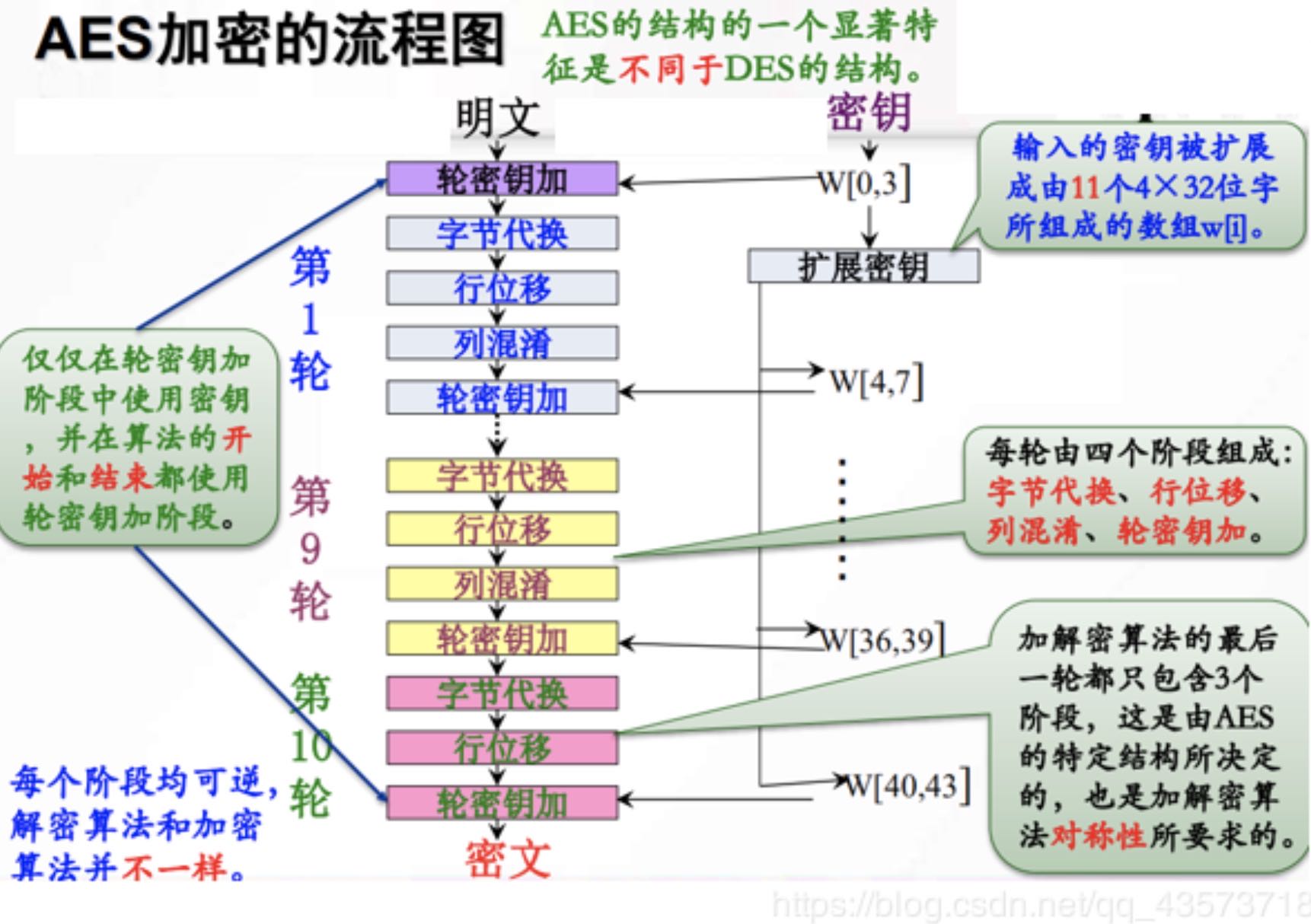

优点:硬件软件的实现都有提升(Atomic operations / small tables in ROM / barrel-shifting registers / fast table lookup routine / Considerable parallelism)
Modes of Operation 可参考维基百科
ECB / CBC / OFB / CFB / CTR / MAC 记忆每种操作的公式以及优缺点
3. hash
性质:Takes on input of any size / Produces fixed-length output / Easy to compute (efficient) / One-Way-ness Weak Collision-Resistance / Strong Collision-Resistance
Merkle-Damgard construction
Compression function f(): fixed-size output
Birthday Paradox

CHF from a Block Cipher:Hi = E ( Mi, Hi-1 ), H0= 0
Davies-Meyer CHF:Hi = Hi-1 ⊕ E ( Mi, Hi-1 ), H0= 0
-》Final ciphertext Hp is the hash output
Hash Func Examples:MD5 (defunct 失灵的) / SHA-1(weak) / SHA-256(SHA-2 family 仍在使用) / SHA-3
Message Authentication:哈希函数除了能保证消息的完整性,还能应用于消息认证
消息认证3种方法:摘自引用2
1.基于消息加密的认证
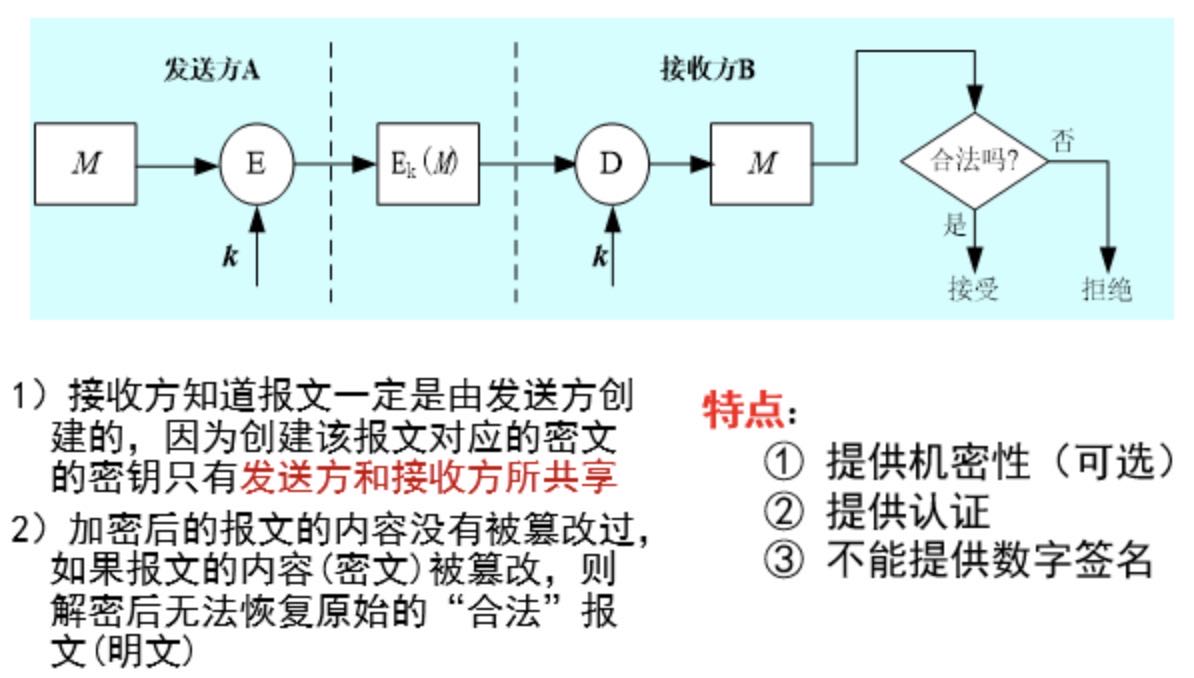
认证是通过双方都知道的密钥,来解密接收到的接收到的消息。如果解密后的结果是一堆乱码,则说明消息不合法,不是对方发送的。
2.基于消息认证码(MAC)的认证
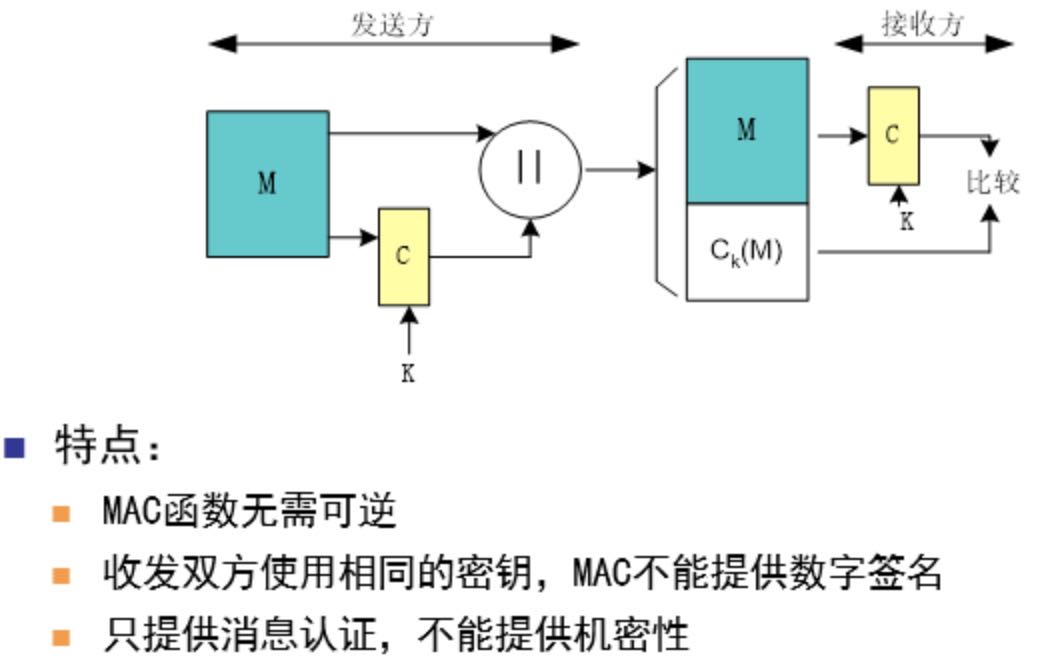
一般来说发送方发送 M + E(K, H(M)) 给接收方,存在的问题是可能存在哈希碰撞被hacker发现可以伪造 (forgery) 数据,可以考虑 H(K || M)
Just computing and appending H(m) to m is enough for integrity but not for authenticity -> 【?】有点无法理解,如果只有 H(m) 的话那不是任何人都能篡改吗,为什么还能提供完整性的证明?
如何提供 authenticity (消息的可靠性和真实性):
Prefix: MAC=H(K || M) 基本上可行,但是 allows concatenation with arbitrary message H(K || M || M’)
Suffix: MAC=H(M || K) 会比前者可靠,但是 what if M’ is found such that H(M)=H(M’)
HMAC: MAC=H(K || H(K || M)) 被提出,应用在 IP security / TLS / IPSec 等领域
❓ 这部分需要后续跟进,对 integrity 和 authenticity 更精确的定义,以及为什么Prefix / Suffix / HMAC 的表现是这样?
3.基于哈希函数的认证
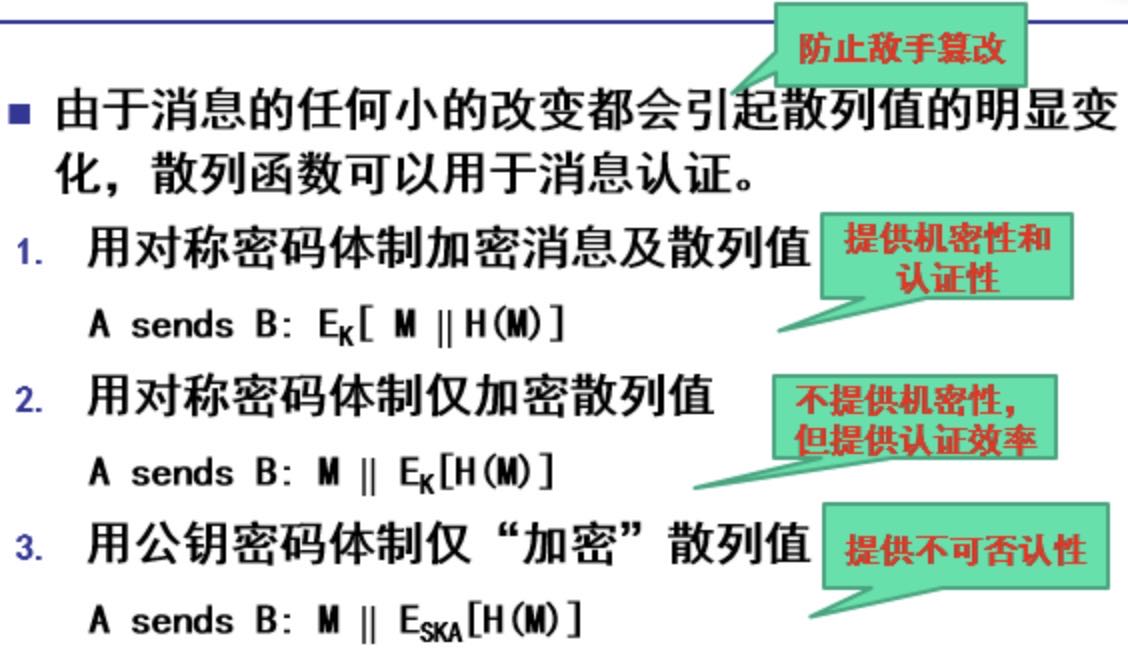
4. number theory
判断有限代数结构(Finite Algebraic Structures)
- Group (G,@): closure / associativity / identity / inverse
- Abelian 阿贝尔群/交换群: commutativity
- Cyclic: group generator
G=<g> - Order of a group: the size of set G
|G|or#{G}orord(G) - Group (G,@) is finite if ord(G) is finite
- Rings (R, +, *): (R, +) is an Abelian group (identity=0) & closure / associativity / identity=1 / distribution
- Monoid: associative / identity
- Fields (F, +, *): Commutative Ring + Inverse(*)
- Subgroup (G,@): H is a subset of G & (H, @) is a group
Some cases hard to understand:
- Integers mod(p) (where p is Prime) under Multiplication -> Nonzero integers mod p -> 这个集合包含所有模p等于1,2,…,(p-1)的数
- non-zero integers mod N = {1 …, x, … n-1} such that GCD(x, N)=1 -> 这个集合包含所有模n等于1,2,…,(n-1)的数,和前一个的区别在于这里 N 不一定是质数,任何数都可以
extended euclidian algorithm IRTQ法求逆
chinese remainder theorem(CRT) 可用于RSA的优化
5. asymmetric encryption
Encryption & Decryption / Digital signatures (Provides authentication (认证,是不是对方发的?), integrity (消息有没有被中间人恶意篡改?), and non-repudiation (不可抵赖的 😭 考试有填空只记得中文了))
Key exchange: Diffie–Hellman key exchange
RSA:记忆流程 / 理解可以解密的原理 / 可行性的前提,为什么安全 / 复杂度分析,如何优化 Square-and-Multiply(快速幂) Speeding up RSA Decryption 利用中国剩余定理 / why 2 or more parties cannot share the same n / RSA Signature Scheme 很不安全
El Gamal:记忆流程 / 理解可以解密的原理 / 可行性的前提,为什么安全 / 优缺点 / El Gamal Signature 安全性,对存在性伪造的防范?看起来证明有点复杂 /
6. cryptographic protocol
Zero-knowledge proof 字面上的意思,不泄露秘密地证明自己 / 漆黑的洞穴
Fiat-Shamir Identification Scheme
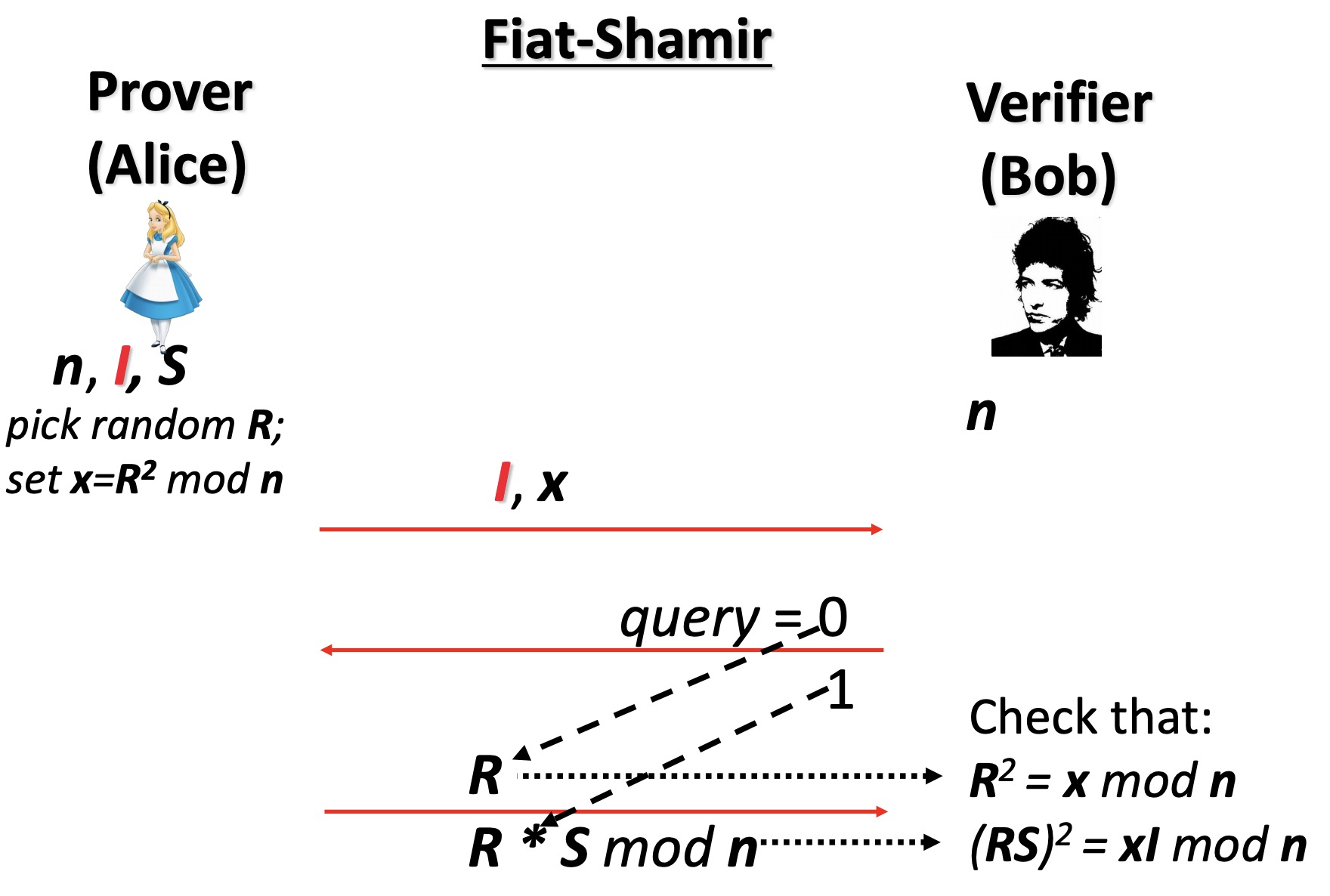
通常会轮询个 20, 30, or log n 次,保证 Prover (Eve) 不能事先知道 query 是0还是1
还没了解怎么证明这个协议是 zero-knowledge 的?
7. authentication/identification
Secure Protocols:protocols / entities parties / rounds / messages 定义
Basis for Authentication:Something you know / Something you have / Something you are (好吧,考试又挂了,意思是差不多不知道给不给分)
具体场景 / 分析每种方式的优点和局限性
Authentication (Protocols):Protocol ap1.0 - Protocol ap2.0 - Protocol ap3.0 - Protocol ap3.1 - Protocol ap4.0 - Protocol ap5.0
The Protocol (Nonces):除了使用key外,还可以使用 sequence 和 time-stamps
8. Key Distribution
Conventional (Secret) key distribution / Public key distribution
Trusted Intermediaries
Key Distribution Center (KDC) 也叫 Trusted Third Part (TTP)
Reference
- UCI CS134 课件(mainly)
- 现代密码学复习要点总结(谷利泽)